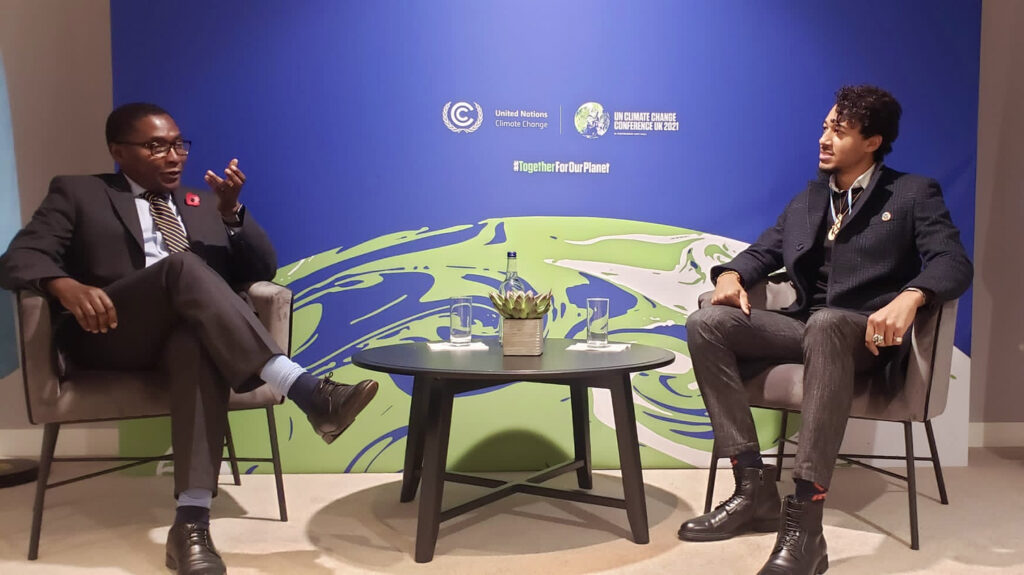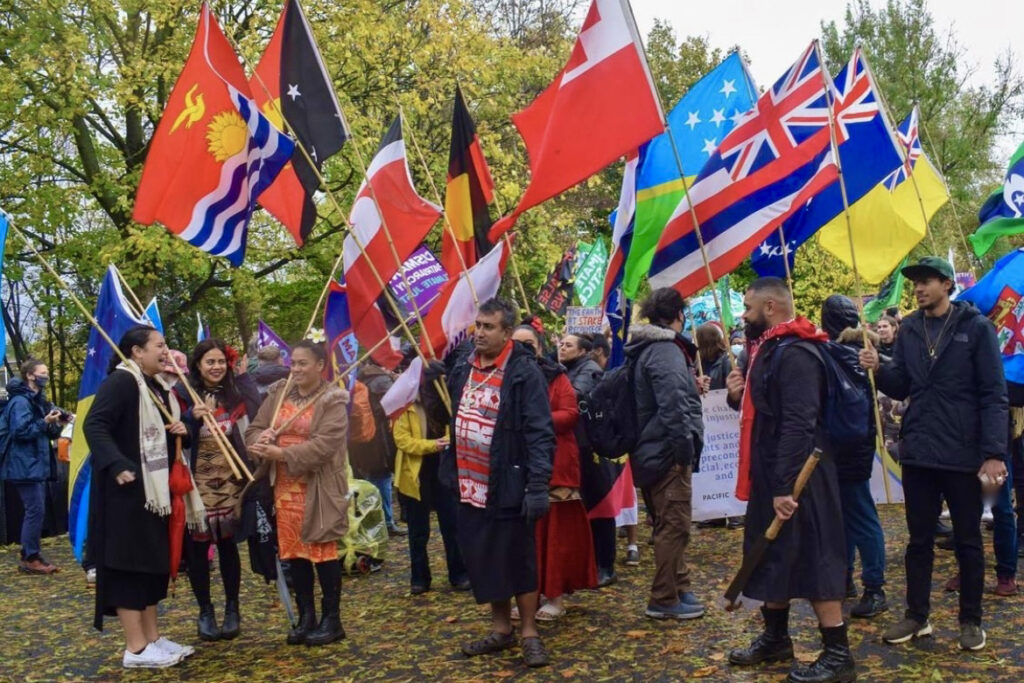Law student combines activism and policy development to fight climate change
Rayne Sullivan, a second-year student at Stanford Law School, served as a delegate to the 2021 United Nations Climate Change Conference in Glasgow, Scotland, and was one of two U.S. representatives at the United National Climate Youth Summit in Milan, Italy.
Growing up in South Florida and as a Hawai’i resident, Rayne Sullivan, a second-year student at Stanford Law School, has seen firsthand the effects of the climate crisis, including extreme flooding from a rise in sea levels, destruction of crops and food supply and exacerbation of the loss in biodiversity.

Rayne Sullivan meets with Ambassador Selwin Hart, special adviser to the secretary-general and assistant secretary-general of the Climate Action Team, to discuss island policy and youth engagement. (Image credit: Courtesy Rayne Sullivan)
Due to their low-lying ocean borders, small land masses and exposure to extreme weather conditions, island systems are seen as particularly vulnerable to the effects of climate change.
Sequestered at home on O’ahu throughout the pandemic (with concentrated beach time in between Zoom law school classes), Sullivan reaffirmed his passion for his island homelands and reawakened his deep concern about the climate crisis’ risk to human health, livelihoods and physical space in his community.
Living in Hawai’i also reaffirmed his drive to continue empowering young, diverse voices to advocate for climate policies that will improve their lives and their lands.
That passion for the islands and the desire to bring the views of diverse youth to speak truth to power brought Sullivan to the pinnacle of all climate talks, COP26. He served as a delegate at the 2021 United Nations Climate Change Conference in Glasgow, Scotland, shortly after serving as one of just two U.S. representatives for the United Nations Climate Youth Summit in Milan, Italy, from Sept. 28-30.
In the weeks between the two conferences, along with diving into his mid-quarter law classes, Sullivan spoke at various events and worked on policy recommendations in the Youth4Climate Manifesto that was later discussed at COP in a dedicated high-level ministerial meeting led by UNFCCC (United Nations Framework Convention on Climate Change) Executive Secretary Patricia Espinosa, COP26 President Alok Sharma and Italy’s Minister for Ecological Transition Roberto Cingolani.
While at COP26, Sullivan also worked on the Local2030 Islands Network, meeting with ministers and officials from the Maldives, New Zealand and Barbados. The Local2030 Islands Network is the world’s first global, island-led network devoted to advancing the U.N. Sustainable Development Goals through locally-driven, culturally-informed solutions and is supported by John Kerry, special presidential envoy for climate, and President Biden’s Emergency Plan for Adaptation and Resilience (PREPARE).
“At these summits, my goal was to ensure there is a permanent space for youth, not only to have a seat at the table but to build and lead that table,” Sullivan said. “Indigenous and frontline communities must be given the opportunity to not only cooperate and assist but to be the chief architects and leaders of the fight against climate change. Racial and environmental justice issues must be rectified, not exacerbated, during this fight.”
COP26, a 12-day conference that aimed to prioritize the protection of Earth’s natural systems through the collaboration of organizations and government groups from all over the world, resulted in climate pledges including deforestation commitments, deals that set limits on coal and a plan to disinvest from fossil fuel initiatives.
Sullivan used his unique experience as a multiracial environmental advocate to support multilateral initiatives at the conference, where he interacted with heads of state, senior diplomats, and fellow advocates.
Harnessing nature as both a model and a mentor
During his presentations and speaking engagements at both climate conferences, Sullivan highlighted the importance of being aware of humans’ position in nature and the critical approaches of reciprocity that he believes are prioritized by many Indigenous and frontline communities: “To take care of the land and to love the land, thus taking care and loving ourselves.”

Sullivan (far right) joins the Climate Warriors for a protest march in front of the COP26 meeting in Glasgow.
Sullivan pressed the point that climate solutions must be grounded in an Indigenous framework that promotes sustainable and equitable futures. As an avid fan of new technological advancements, he advanced the idea that such achievements can actually facilitate the upkeep of longstanding cultural traditions. For example, fidelity measurements, biocultural restoration, video game design and even natural language processing can help preserve and promote culture.
While playing a critical role at COP26, Sullivan found time to participate in the youth protests held right outside of COP26 by Greta Thunberg, Vanessa Nakate and others. He acknowledged his roots in youth-led grassroots work and protested alongside the Pacific Climate Warriors, a youth-led grassroots network working with communities to fight climate change from the Pacific Islands. Sullivan hopes to continue bridging the gap between legal and policy work while encouraging larger discussions and movements such as this.
The journey to law
Driven to preserve and protect his island homelands against the ravages of climate change, Sullivan applied to law schools across the country, eventually transferring to Stanford Law after completing his first year of law school at Columbia via Zoom. “I wanted to learn the law at a place where environmental law and tech law intersected at climate justice,” he said. “Naturally, that place was Stanford.”
Sullivan was interested in an environmental law program that would provide opportunities to support his own scholarship, whether it’s working on a tribal commercial code in the Yurok Tribe Policy Lab, taught by Elizabeth A. Reese, an assistant professor of law, or researching the legal underpinnings of climate reparations and sovereignty through directed research with Buzz Thompson, the Robert E. Paradise Professor of Natural Resources Law.
“The climate crisis touches each and every community in the world,” Sullivan said. “We need to make sure that we’re not only creating sources and economies of abundance, but that we’re also putting the resources for peace and community building at all levels.”
